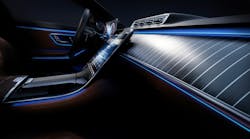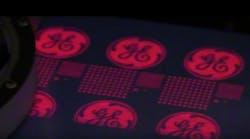A team of researchers from GE Global Research, GE Lighting, and the University of Maryland have demonstrated an LED lamp that produces the equivalent 1500-lm light output of a 100W PAR38 halogen bulb while using only a third of the energy. The prototype uses a cooling scheme that allows fewer LEDs to be driven at higher currents to provide the drastic reduction in energy usage.
The cooling technology is called “dual cool jets.” GE didn’t detail the operational characteristics of the new lamp, but did state that the cooling scheme “reduces the number of LED chips required” to achieve the 1500-lm output. The prototype runs the LEDs at higher current levels while the cooling scheme mitigates what would normally be adverse thermal results from such high-power operation.
“This is a revolutionary cooling technology with great promise. It has the potential to help us take LED lighting performance and efficiency to new heights,“ said GE mechanical engineer Mehmet Arik. “Through further research and improvements, we may be able to increase performance without compromising the efficiency or lifetime of an LED bulb.”
The GE announcement heralded the fact that the cooling technology comes from its fluidics experts working on aviation and aerospace projects. The heritage is techniques used to control airflow and combustion in aircraft engines,
In LED lamps, the techniques are applied to generate airflow that can cool the LED heat sinks. The dual cool jets are micro-fluidic bellows that emit high-velocity jets of air on the heat sink. According to GE, the cooling technology provides ten times better heat transfer rate than can convection cooling schemes. The improved cooling “enables LED operation at high drive currents without losses in efficiency or lifetime.”
“Just one floor down in the same research building, I have colleagues using our dual cool jets technology to improve both the power and efficiency of GE’s jet engines and power generation turbines, said Arik. “With wind turbines, for example, we’re manipulating airflow to increase wind energy production. With LEDs, we’re using dual cool jets to improve the heat transfer rate and reduce the number of chips in the lamp.”
In fairness, GE certainly isn’t the first company to develop an air-jet-centric cooling scheme. Indeed Nuventix is shipping the second generation of its SynJet cooling products.
There is also some level of resistance to any active cooling scheme within the lighting industry, even though the bellows-driven air jets should prove far more reliable than legacy fans. For example, the purchasing specification developed by the San Diego Street Light Working Group specifies no active cooling devices in LED street light luminaires.






